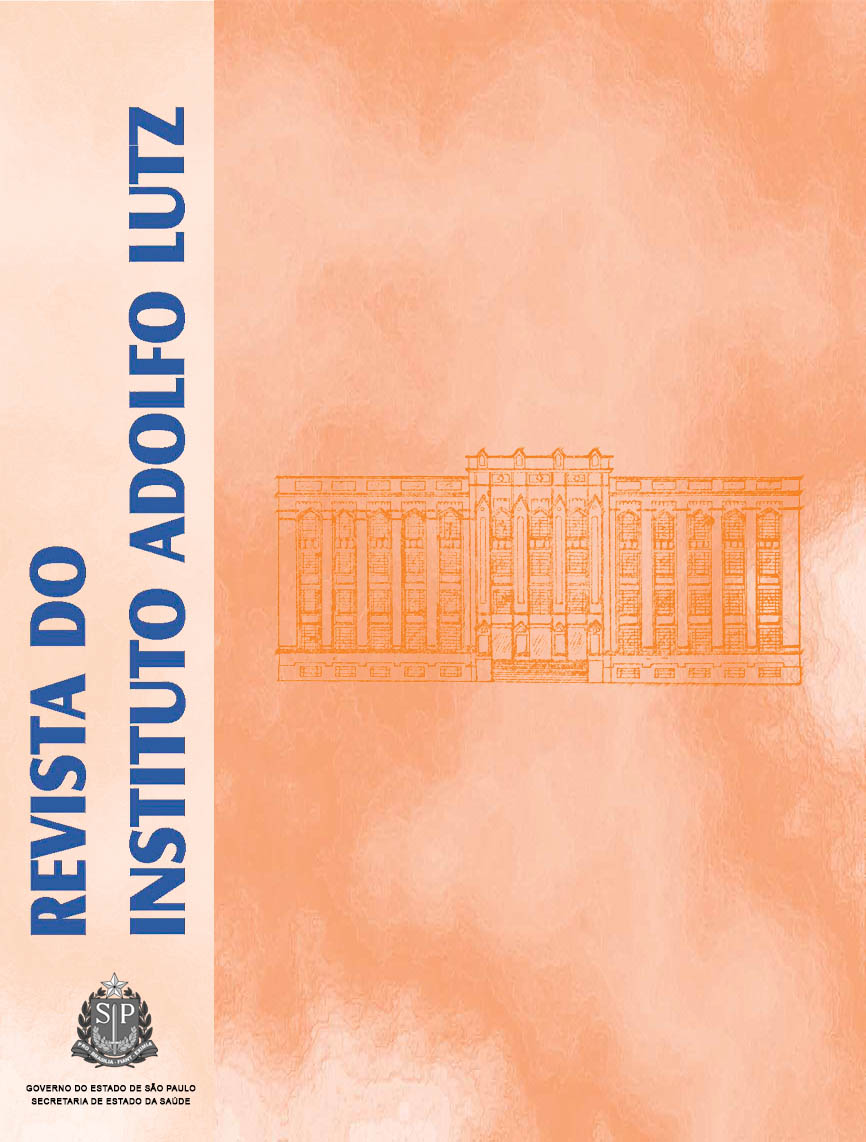Abstract
Salmonella Enteritidis is the main cause of salmonellosis. The use of antimicrobials to prevent and to treat this infection, as well their use like growth promoters, has induced the emergency of resistants trains. The aim of this work was to search the presence of Salmonella in poultry products and to investigate the isolates resistance to antimicrobial agents. One hundred and twenty samples of poultry products were analyzed, according to the Food and Drug Administration. Salmonella was isolated from seven (15.83%) samples and four serotypes were identified, Enteritidis, Newport, Derby and Agona. Enteritidis was the most prevalent serotype (71.4%). Thirty-six (94.7%), 34 (89.5%), 32 (84.2%) and 32 (84.2%) isolates were susceptible to chloramphenicol, norfloxacin, ciprofloxacin and ampicillin, respectively. Thirty-three (86.8%) isolates were resistant to nalidixic acid. All isolates (100%) were susceptible to ceftriaxone. Twenty-five isolates (65.8%) were resistant to tetracycline. Five isolates (13.2%) multiresistant were found. The inspection of poultry products must be more rigorous, regarding to the possible presence of Salmonella. The occurrence of Salmonella strains resistant to antimicrobial agents is indicative of more control necessity in use of these drugs.References
1. D‘Aoust J, Maurer J, Bailey JS. Salmonella species. In: Doyle MP, Beuchat LR, Montville TJ, editores. Food microbiology: fundamental and frontiers. 2th ed. Washington: ASM; 2001. p.141-77.
2. Jay JM. Microbiologia moderna de los alimentos. 3rd ed. Zaragoza: Editorial Acribia; 1992.
3. Peresi JTM, Lima IAZC, Tavechio AT, Fernandes SA, GelliDS. Salmonella: determinação de sorotipos e resistência a agentes microbianos de cepas isoladas de carcaças defrango comercializadas na região de São José do Rio Preto-SP. Rev Inst Adolfo Lutz. 1999; 58(1): 41-6.
4. Sumner J, Raven G, Givney R. Have changes to meat and poultry food safety regulation in Australia affected the prevalence of Salmonella or of salmonellosis? Int J Food Microbiol. 2004; 92 (2): 199-205.
5. Chiappini E, Galli L, Pecile P, Vierucci A, Martino M. Results of a 5-year prospective surveillance study of antibiotic resistance among Salmonella enterica isolates and ceftriaxone therapy among children hospitalized foracute diarrhea. Clin Ther. 2002; 24 (10): 1585-94.
6. Threlfall EJ, Ward LR, Frost JA, Willshaw GA. The emergence and spread of antibiotic resistance in food-borne bacteria. Int J Food Microbiol. 2000; 62: 1-5.
7. White DG, Zhao S, Simjee S, Wagner DD, Mcdermott PF. Antimicrobial resistance of food-borne pathogens. Microb Infect. 2002; 4: 405-12.
8. Angulo FJ, Baker NL, Olsen SJ, Anderson A, Barret TJ. Antimicrobial use in agriculture: controlling the transferof antimicrobial resistance to humans. Sem Pediatr InfectDis. 2004; 15 (2): 78-85.
9. Yan SS, Pendrak ML, Abela-Ridder B, Punderson VMD, Fedorko DP, Foley SL. An overview of Salmonella typing public health perspectives. Clin Appl Immunol Rev. 2003;4: 189-204.
10. Food and Drug Administration. Salmonella. Bacteriological analytical manual online, Chapter 5, 2006. Disponível em: <http://www.cfsan.fda.gov/~ebam/bam-5.html>. Acesso em: 12 jun. 2006.
11. National Committee for Clinical Laboratory Standards. Performance standards for antimicrobial disk and dilution susceptibility test for bacteria isolated from animals, Approved Standard, 2nd ed. M31-A2. National Committee for Clinical Laboratory Standards, Wayne (PA), USA, 2002.
12. Conceição RCS. Detecção de Salmonella em produtos de frango usando a separação imunomagnética [Dissertaçãode Mestrado]. Pelotas, Rio Grande do Sul: Universidade Federal de Pelotas, 2004.
13. Baú AC, Carvalhal JB, Aleixo JAG. Prevalência de Salmonella em produtos de frangos e ovos de galinha comercializados em Pelotas, RS, Brasil. Ciênc Rural. 2001;31 (2): 303-7.
14. Matheus DP, Rudge AC, Gomes SMM. Ocorrência de Salmonella spp em carne de frango comercializada no município de Bauru, SP, Brasil. Rev Inst Adolfo Lutz. 2003;62 (2): 111-5.
15. Mayrhofer S, Paulsen P, Smulders FJM, Hilbert F. Antimicrobial resistance profile of five major food-borne pathogens isolated from beef, pork and poltry. Int J Food Microbiol. 2004; 97: 23-9.
16. Antunes P, Réu C, Sousa JC, Peixe L, Pestana N. Incidence of Salmonella from poultry products and their susceptibility to antimicrobial agents. Int J Food Microbiol.2003; 82: 97-103.
17. Carramiñana JJ, Rota C, Agustín I, Herrera A. Highprevalence of multiple resistance to antibiotics in Salmonella serovars isolated from a poultry slaughter housein Spain. Vet Microbiol 2004; 104: 133-39.
18. Fernandes SA, Ghilardi ACR, Tavechio AT, Machado AMO, Pignatari ACC. Phenotypic and molecular characterization of Salmonella Enteritidis strains isolatedin São Paulo, Brazil. Rev Inst Med trop S Paulo. 2003; 45(2): 59-63.
19. Delicato EL, Mickcha JMG, Fernandes SA, Pelayo JS. Resistance profile to antimicrobials of Salmonella spp. isolated from human infections. Braz Arch Biol Technol. 2004; 47 (2): 193-7.
20. Calixto AER, Serafini AB, Kipnis A, André MCDP.Prevalência de Salmonella e ocorrência de cepas resistentes a antimicrobianos, em insumos de rações para aves produzidos por um matadouro-frigorífico com fiscalização permanente, em Goiânia, GO. Hig Alim. 2002;16 (101): 56-62.
21. Oliveira SD, Flores FS, Santos LR, Brandelli A.Antimicrobial resistance in Salmonella Enteritidisstrains isolated from broiler carcasses, food, human andpoultry-related samples. Int J Food Microbiol. 2005;97(3): 297-305.
22. Stephen JM, Toleman MA, Walsh TR, Jones RN, SENTRY Program Participants Group. Salmonella blood stream infections: report from SENTRY Antimicrobial Surveillance Program (1997-2001). Int J Antimicrob Agents. 2003; 22: 395-405.
23. Pickering LK. Antimicrobial Resistance Among Enteric Pathogens. Sem Pediatr Infect Dis. 2004; 15 (2): 71-7.

This work is licensed under a Creative Commons Attribution 4.0 International License.
Copyright (c) 2007 Instituto Adolfo Lutz Journal
